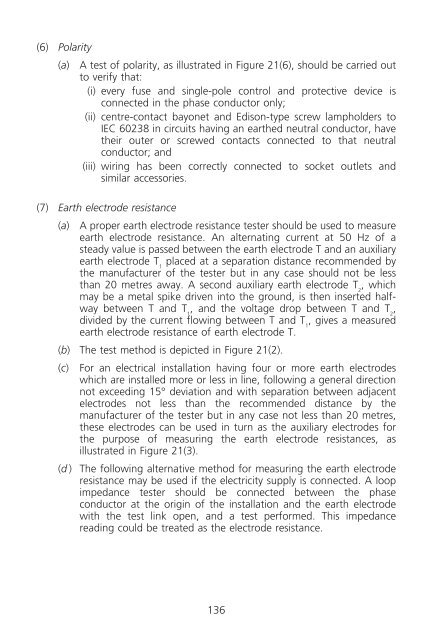Code of Practice for the Electricity (Wiring) Regulations - 2009 Edition
Code of Practice for the Electricity (Wiring) Regulations - 2009 Edition
Code of Practice for the Electricity (Wiring) Regulations - 2009 Edition
You also want an ePaper? Increase the reach of your titles
YUMPU automatically turns print PDFs into web optimized ePapers that Google loves.
(6) Polarity<br />
(a) A test <strong>of</strong> polarity, as illustrated in Figure 21(6), should be carried out<br />
to verify that:<br />
(i) every fuse and single-pole control and protective device is<br />
connected in <strong>the</strong> phase conductor only;<br />
(ii) centre-contact bayonet and Edison-type screw lampholders to<br />
IEC 60238 in circuits having an ear<strong>the</strong>d neutral conductor, have<br />
<strong>the</strong>ir outer or screwed contacts connected to that neutral<br />
conductor; and<br />
(iii) wiring has been correctly connected to socket outlets and<br />
similar accessories.<br />
(7) Earth electrode resistance<br />
(a) A proper earth electrode resistance tester should be used to measure<br />
earth electrode resistance. An alternating current at 50 Hz <strong>of</strong> a<br />
steady value is passed between <strong>the</strong> earth electrode T and an auxiliary<br />
earth electrode T placed at a separation distance recommended by<br />
1<br />
<strong>the</strong> manufacturer <strong>of</strong> <strong>the</strong> tester but in any case should not be less<br />
than 20 metres away. A second auxiliary earth electrode T , which<br />
2<br />
may be a metal spike driven into <strong>the</strong> ground, is <strong>the</strong>n inserted halfway<br />
between T and T , and <strong>the</strong> voltage drop between T and T ,<br />
1 2<br />
divided by <strong>the</strong> current flowing between T and T , gives a measured<br />
1<br />
earth electrode resistance <strong>of</strong> earth electrode T.<br />
(b) The test method is depicted in Figure 21(2).<br />
(c) For an electrical installation having four or more earth electrodes<br />
which are installed more or less in line, following a general direction<br />
not exceeding 15° deviation and with separation between adjacent<br />
electrodes not less than <strong>the</strong> recommended distance by <strong>the</strong><br />
manufacturer <strong>of</strong> <strong>the</strong> tester but in any case not less than 20 metres,<br />
<strong>the</strong>se electrodes can be used in turn as <strong>the</strong> auxiliary electrodes <strong>for</strong><br />
<strong>the</strong> purpose <strong>of</strong> measuring <strong>the</strong> earth electrode resistances, as<br />
illustrated in Figure 21(3).<br />
(d ) The following alternative method <strong>for</strong> measuring <strong>the</strong> earth electrode<br />
resistance may be used if <strong>the</strong> electricity supply is connected. A loop<br />
impedance tester should be connected between <strong>the</strong> phase<br />
conductor at <strong>the</strong> origin <strong>of</strong> <strong>the</strong> installation and <strong>the</strong> earth electrode<br />
with <strong>the</strong> test link open, and a test per<strong>for</strong>med. This impedance<br />
reading could be treated as <strong>the</strong> electrode resistance.<br />
136














